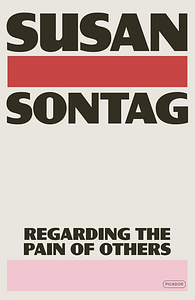You need to sign in or sign up before continuing.
Take a photo of a barcode or cover
challenging
medium-paced
I understand why she didn't include pictures, but would have still liked to see the photographs she talks about. Interesting perspectives on photography and the use of art and news.
Last two concluding chapters were very insightful. If Sontag embedded photographs within her narrative, the book could have been a much better book. I constantly had to google the images that she was talking about.
--------------
"The photographs are a means of making "real" (or "more real") matters that the privileged and the merely safe might prefer to ignore" (7).
= Photographs embedded in novels - making them imagined archives. But how about newspaper? Novel contextualize and narrative more thoroughly?
- We are good people, or I should say, most of us are good people, but we lack moral imaginations.
"And all photographs wait to be explained or falsified by their captions. During the fighting between Serbs and Croats at the beginning of the recent Balkan wars, the same photographs of children killed in the shelling of a village were passed around at both Serb and Croat propaganda briefings. Alter the caption, and the children's deaths could be used and reused" (10). <= paraphrase this.
- What makes photos in auto-fiction different from just photos in general or even photos in newspaper?
- What I would call "quiet sufferings." Sufferings of the voiceless (especially children in both novels) Compared to war photos.
"...transmitted tersely and emphatically." Then, through novels, how are these photos transmitted? is it more than tersely and emphatically?
Experience of a real catastrophe vs. experience of its representation
The content of the novel can be a caption for those archival photographs.
...the weight of words.
"Photographs had the advantage of uniting two contradictory features. Their credentials of objectivity were in-built. Yet they always had, necessarily, a point of view. They were a record of the real--incontrovertible, as no verbal account, however impartial, could be--since a machine was doing the recording. And they bore witness to the real--since a person had been there to take them" (26)
"...allows photographs to be both objective record and personal testimony, both a faithful copy or transcription of an actual moment of reality and an interpretation of that reality--a feat literature has long aspired to, but could never attain in this literal sense."***
"The less polished pictures are not only welcomes as possessing a special kind of authenticity." Not staged photos. In both novels, photos are hazy and amateurish. -- "the bias toward the spontaneous, the rough, the imperfect."
Imbuing story into a mere archival material: "Whether the photograph is understood as a naive object or the world of an experienced artificer, its meaning--and the viewer's response--depends on how the picture is identified or misidentified; that is, on words." P.29
But one day captions will be needed, of course. And the misreadings and the misrememberings, and new ideological uses for the pictures, will make their difference. P. 29 ****
- "The caption of a photograph is traditionally neutral informative: a date, a place, names."
"Sentiment is more likely to crystallize around a photograph than around a verbal slogan" (85).
"To remember is, more and more, not to recall a story but to be able to call up a picture. Event a writer as steeped in ineteenth-century and early modern literature solemnities as W.G. Sebald was moved to seed his lamentation-narratives of lost lives, lost nature, lost cityscapes with photographs. Sebald was not just an elegist, he was a militant elegist. Remembering, he wanted the reader to remember, too." P.89***
"A more reflective engagement with content would require a certain intensity of awareness--just what is weakened by the expectations brought to images disseminated by the media, whose leaching out of content contributes most to the deadening of feeling." (106).***
Flood of images; they themselves have little effect now. <-- what can autofiction with photos do to this problem.
"Perhaps too much value is assigned to memory, not enough to thinking (115)."
"Nobody can think and hit someone at the same time."
"Space reserved for being serious is hard to come by in a modern society." (119)
"Every picture is seen in some setting." = where you see certain photographs impresses you differently. Photographs in auto-fiction, different if in archives. (120)
Mix of narrative & image: more powerful in inciting action?
--------------
"The photographs are a means of making "real" (or "more real") matters that the privileged and the merely safe might prefer to ignore" (7).
= Photographs embedded in novels - making them imagined archives. But how about newspaper? Novel contextualize and narrative more thoroughly?
- We are good people, or I should say, most of us are good people, but we lack moral imaginations.
"And all photographs wait to be explained or falsified by their captions. During the fighting between Serbs and Croats at the beginning of the recent Balkan wars, the same photographs of children killed in the shelling of a village were passed around at both Serb and Croat propaganda briefings. Alter the caption, and the children's deaths could be used and reused" (10). <= paraphrase this.
- What makes photos in auto-fiction different from just photos in general or even photos in newspaper?
- What I would call "quiet sufferings." Sufferings of the voiceless (especially children in both novels) Compared to war photos.
"...transmitted tersely and emphatically." Then, through novels, how are these photos transmitted? is it more than tersely and emphatically?
Experience of a real catastrophe vs. experience of its representation
The content of the novel can be a caption for those archival photographs.
...the weight of words.
"Photographs had the advantage of uniting two contradictory features. Their credentials of objectivity were in-built. Yet they always had, necessarily, a point of view. They were a record of the real--incontrovertible, as no verbal account, however impartial, could be--since a machine was doing the recording. And they bore witness to the real--since a person had been there to take them" (26)
"...allows photographs to be both objective record and personal testimony, both a faithful copy or transcription of an actual moment of reality and an interpretation of that reality--a feat literature has long aspired to, but could never attain in this literal sense."***
"The less polished pictures are not only welcomes as possessing a special kind of authenticity." Not staged photos. In both novels, photos are hazy and amateurish. -- "the bias toward the spontaneous, the rough, the imperfect."
Imbuing story into a mere archival material: "Whether the photograph is understood as a naive object or the world of an experienced artificer, its meaning--and the viewer's response--depends on how the picture is identified or misidentified; that is, on words." P.29
But one day captions will be needed, of course. And the misreadings and the misrememberings, and new ideological uses for the pictures, will make their difference. P. 29 ****
- "The caption of a photograph is traditionally neutral informative: a date, a place, names."
"Sentiment is more likely to crystallize around a photograph than around a verbal slogan" (85).
"To remember is, more and more, not to recall a story but to be able to call up a picture. Event a writer as steeped in ineteenth-century and early modern literature solemnities as W.G. Sebald was moved to seed his lamentation-narratives of lost lives, lost nature, lost cityscapes with photographs. Sebald was not just an elegist, he was a militant elegist. Remembering, he wanted the reader to remember, too." P.89***
"A more reflective engagement with content would require a certain intensity of awareness--just what is weakened by the expectations brought to images disseminated by the media, whose leaching out of content contributes most to the deadening of feeling." (106).***
Flood of images; they themselves have little effect now. <-- what can autofiction with photos do to this problem.
"Perhaps too much value is assigned to memory, not enough to thinking (115)."
"Nobody can think and hit someone at the same time."
"Space reserved for being serious is hard to come by in a modern society." (119)
"Every picture is seen in some setting." = where you see certain photographs impresses you differently. Photographs in auto-fiction, different if in archives. (120)
Mix of narrative & image: more powerful in inciting action?
medium-paced
very brilliant writing, this small book gave me a lot to think about for sure. I especially appreciated her thoughts on the ways in which our distance from tragedy dictates how we engage with photographs of those atrocities. also part of this discussion is the difference in the way photographers treat their subjects- “the more remote or exotic the place, the more likely we are to have full frontal views of the dead and dying”
reflective
medium-paced
dark
informative
reflective
tense
slow-paced
challenging
dark
emotional
reflective
tense
slow-paced
challenging
fast-paced
challenging
informative
medium-paced
I firstly praise this for pulling me out of my months-long reading slump. This was a fascinating and insightful read holding so many memorable lines, I’ll be recommending this to everyone I know.
(Thanks Emma Angeline for mentioning this in one of your videos)
(Thanks Emma Angeline for mentioning this in one of your videos)
Susan Sontag isn’t the declarative type, however she is refreshingly clear about something that should be patently obvious: that reality exists independent of the photograph depicting that reality. Only in a postmodern fuckfest of a culture would such an assertion be worth the page or ink, alas here we are. But Sontag’s clarity isn’t a constant, it’s often obfuscated by a bizarre commitment to a humanism that allows her, on one page, to sympathize with the Taliban (they too might have sisters! Wives!) and, just three pages later, comment on the "beauty" of the photos capturing the destruction of 9/11.
Sontag's point here and elsewhere isn’t (solely) that men bad, America bad, empire bad, but still an egregious number of passages serve no valuable purpose outside this relativistic prodding. As such, this essay feels like it's from another era, a time when leering at a "masculine issue" with a feminist lens was, unto itself, the lone requirement to make the issue seem fresh. But gone are the days when problematizing was enough, when logical conclusions were acceptably evasive or non-existent. Now are the days when I expect declarations to be made.
Sontag's point here and elsewhere isn’t (solely) that men bad, America bad, empire bad, but still an egregious number of passages serve no valuable purpose outside this relativistic prodding. As such, this essay feels like it's from another era, a time when leering at a "masculine issue" with a feminist lens was, unto itself, the lone requirement to make the issue seem fresh. But gone are the days when problematizing was enough, when logical conclusions were acceptably evasive or non-existent. Now are the days when I expect declarations to be made.




